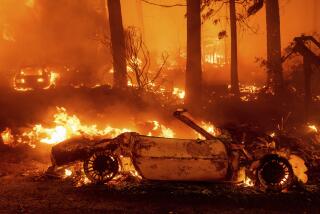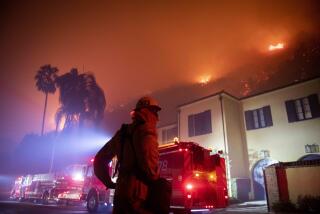Insurers roll even before smoke clears
Insurance adjusters and company executives began hitting Southern California in full force Tuesday, beginning the complex job of assessing fire damage and helping homeowners and renters deal with claims.
By early afternoon, the state’s biggest home insurer, State Farm General, and No. 2 Farmers Insurance Group said they’d received more than 2,100 claims from calls to toll-free numbers, contacts with agents and visits to field offices.
Farmers rolled a “mobile claims command center” to an evacuation center near Qualcomm Stadium in San Diego and served 1,000 breakfasts to evacuees Tuesday morning. “We want people to see that their insurance company is out here,” said Paul N. Hopkins, Farmers’ chief executive.
State Farm spokesman Bill Sirola said his company also was moving in mobile units and “is well into the process of mobilization.”
A third insurer, American International Group Inc., was even more proactive. Its Private Client Group subsidiary dispatched six special trucks to spray retardant on the vegetation and wood portions of policyholders’ multimillion-dollar homes threatened by fast-moving fires.
“We think it provides enhanced protection from extensive damage,” said Stan Rivera, the company’s director of wildfire protection.
But with more than 1,100 homes already destroyed, California Insurance Commissioner Steve Poizner estimated that total damages would exceed “hundreds of millions of dollars,” making the October wildfires some of the costliest in California history.
Poizner said his office was monitoring the insurance companies to “make sure these claims get processed as rapidly as possible.”
The most expensive wildfire in U.S. history occurred in the Oakland Hills in October 1991, with $1.7 billion in insured losses ($2.5 billion in 2006 dollars). Since 1970, nine of the 10 costliest fires in the United States occurred in California, according to the Insurance Information Institute, a national industry group.
Last year, California wildfires destroyed 678,906 acres, according to the National Interagency Coordination Center. Only Texas lost more to fire.
The latest fires are just the sort of catastrophe that prompted third-ranked Allstate Corp. in May to stop writing new policies for homeowners.
The insurer also is seeking a major rate increase for current policyholders, citing danger from fires.
That could spell trouble for California homeowners “if other insurance companies choose to look at it like that,” warned Douglas Heller of the Foundation for Taxpayer and Consumer Rights in Santa Monica.
State Farm and Farmers said emphatically this week that they had no plans to follow Allstate’s lead.
“Southern California is Farmers’ home and its territory,” CEO Hopkins said. Los Angeles-based Farmers is a unit of Switzerland’s Zurich Financial Services. “I hope other carriers don’t look at this as a time to try to take on horrendous rate increases or try to leave the state.”
Sirola of State Farm said his company filed its current rates “with the full knowledge that the state is prone to these types of disasters.” Wildfires, he added, were “part of doing business in California.”
Allstate spokesman Peter DeMarco declined to talk about his company’s plans. “Right now, Allstate is focused on providing assistance to those people impacted by the fires,” he said.
Though it’s difficult to plumb each insurer’s plans for the California market, it’s safe to expect rates to go up if the latest outbreak of fires proves expensive, said Robert Hartwig, chief economist for the Insurance Information Institute.
“There appears to be a long-term, upward trend in the frequency and intensity of fires, and the risk has to be reflected in premiums,” he said. “The cost of living in these areas is going to grow.”







